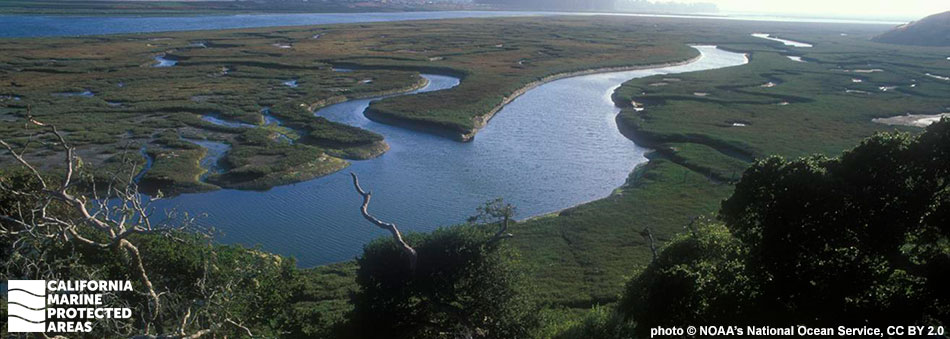
Overview
Elkhorn Slough State Marine Reserve (SMR) and Elkhorn Slough State Marine Conservation Area (SMCA) are marine protected areas (MPAs) located within Elkhorn Slough, a large estuary east of Moss Landing and inland from Monterey Bay. The SMR covers nearly three square miles and the SMCA almost a quarter of a square mile. Together, they protect numerous habitats including tidal mudflats, marshes, eelgrass beds, and beaches.
These habitats are vital for many species of fish including bat rays, leopard sharks and topsmelt, and for invertebrates including ghost shrimp, oysters and moon snails. Marine mammals including harbor seals, sea lions and sea otters, and more than 340 species of birds such as white-tailed kites, Caspian terns, and American white pelicans reside in and use the slough.
Much of the SMR overlaps the Elkhorn Slough National Estuarine Research Reserve, which existed before the MPA implementation. The Reserve is managed by the California Department of Fish and Wildlife in partnership with the National Oceanic and Atmospheric Administration, and with considerable support from the Elkhorn Slough Foundation.
The Elkhorn Slough MPAs have enjoyed multiple layers of protection over many years. They are excellent destinations for wildlife lovers, with abundant marine and avian life, stunning scenery, and calm waters. Kayaking is extremely popular here, attracting thousands of people each year.
Regulations
Elkhorn Slough SMR
It is unlawful to injure, damage, take, or possess any living, geological, or cultural marine resource.
California Code of Regulations Title 14, Section 632(b)(70)(opens in new tab)
Elkhorn Slough SMCA
It is unlawful to injure, damage, take, or possess any living, geological, or cultural marine resource, EXCEPT:
Recreational take of finfish by hook-and-line only, and clams from the slough’s north shore near the Moss Landing State Wildlife Area, is allowed.
California Code of Regulations Title 14, Section 632(b)(71)(opens in new tab)
Quick Facts
Elkhorn Slough SMR
MPA size: 2.72 square miles
Shoreline span: 0.7 miles
Depth range: 0 to 10 feet
Habitat composition*:
- Estuary: 1.65 square miles
- Eelgrass: 0.03 square miles
- Coastal marsh: 3.99 square miles
Quick Facts
Elkhorn Slough SMCA
MPA size: 0.22 square miles
Shoreline span: 0.10 miles
Depth range: 0 to 10 feet
Habitat composition*:
- Estuary: 0.11 square miles
- Eelgrass: 0.01 square miles
- Coastal marsh: 0.44 square miles
*Habitat calculations are based on three-dimensional area and may exceed the total MPA area listed above.